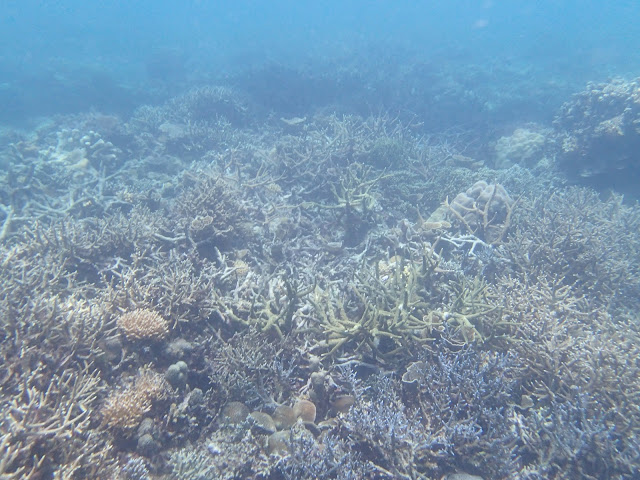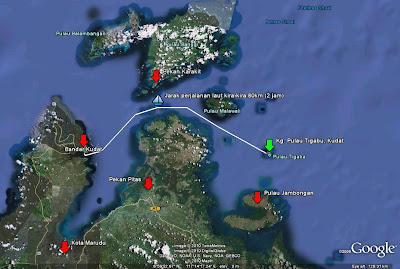The Shocking Truth
My heart beat
unusually fast. The weight of the tank strapped over my shoulder felt heavier
than I thought it should. The octopus regulator was neatly tucked into the
right pocket of my Buoyancy Control Device (BCD). The depth gauge was strapped
tight against my stomach from the left. The regulator dangled at my right,
waiting to be reached. My weight was settled uncomfortably on the edge of the
speedboat. Slowly, I reached for my fins and tightened the straps. My mask
covered my eyes and nose, allowing me to breathe only through my mouth.
Adjusting my weight again, I could hear my heart beat drumming against my ears.
“BCD
inflated?” the boatman asked.
I reached for
the short and black hose-like device on my left and pressed the grey button at
the side a couple of times. The hissing sound of the air filling my BCD could
be heard, as it slowly tightened against my ribs with each press. My heart beat
faster as I reached for the regulator on my right and my teeth clenched neatly over
the mouthpiece. My heart thumped against
my chest.
“Okay, clear!”
the man on the other side of my mask said, looking at me.
Taking two
deep breaths with the regulator, my brain worked really hard to fight the
nervousness and fear that were growing inside me.
Just throw yourself over the edge, you will float and then inflate your
BCD. Breathe through your regulator and do not take it off, no matter what. I
rehearsed the same sentence for the nth-time within the past 10
minutes. I shifted my weight again.
“Take your
time. It’s okay. Go when you are ready,” the boatman said again, smiling at me.
I drew another
deep breath of air into my lungs and placed my palm against regulator with two
fingers in front of my mask.
SPLASH! The
weight of the tank drew me into the water and slowly I surfaced. Frantically, I
pressed the button to inflate my BCD as I emerged from the water. I saw the two
men standing in the speedboat, looking for a sign from me. I checked all my
devices again before raising my right hand over my head, making an ‘O’ signalling
them that I was OK.
I did it! I am in the water and in control! I exclaimed
within.
I felt a tap
over my shoulder and I turn myself to the direction. Ali was there, showing the
“OK” hand sign. I made the circle with my thumb and index finger, replying to
his question. He then signalled me to swim over to the buoy floating about 2
meters away from where we were. I nodded and we swam towards it.
Flipping my
fins, we swam towards the buoy. Once we reached the buoy, Ali signalled the
thumb downwards. We deflated our BCD and slowly the weight of our tanks dragged
us downwards. The coral reefs slowly came into the picture as we slowly came to
hover above them.
For one second
I thought I forgot to breathe. It felt as if you crawled into one of those
documentaries that feature the coral reefs underwater. Oh wait. I am
underwater!
The coral
reefs that lay across the seabed stretched a wide area on my left and right. I
saw my team members floating steadily above the reefs near the buoy line. Ali
signalled me the ‘OK’ sign again to make sure I was managing. I replied before
he swam forward looking for interesting marine creatures to photograph.
 |
| Picture of coral reefs in one of the dive sites in the
proposed © UMS/Muhammad Ali Syed Hussein |
Something is missing in this picture though. I
thought as I paddled a little harder to catch up with Ali. I swam closely
behind him as I looked from left to right, enjoying the underwater view. I was
controlling my buoyancy underwater when the thought struck me.
There are no big reef fish here!
I saw cuttlefish,
butterfly fish, Moorish idol, coral fish, parrot fish but no Humphead wrasse or
adult grouper. Aren’t these fish supposed
to be found in abundance here? I thought.
Butterfly fish.
Parrot fish.
Coral fish.
Moorish Idol.
And more butterfly
fishes.
Yet, no
Humphead wrasse or grouper spotted.
After spending
about an hour underwater, Ali and I surfaced. I was relieved that I had successfully
completed my first dive and did not panic halfway or gulp a huge amount of
saltwater. The bugging thoughts of not spotting a variety of fish species
underwater and the missing commercially important reef fish such as Humphead
wrasse and grouper still lingered at the back of my mind.
Live reef fish,
such as Humphead wrasse (Cheilinus
undulatus), as well as red, brown and giant groupers, are top predators on
reefs but are also the most desirable in the market. The trade of these live
reef fish (LRF) is driven by Hong Kong, mainland China
and other affluent markets in Asia . In 2008 about
90,642 kg of groupers were landed in Malaysia ,
of which approximately 19.6% (including Humphead wrasse) are exported by air
out of Sabah . Due to the profitability and
vulnerability of the fish populations, many species are extremely overfished and
becoming rare in the wild. This has eventually led to the use of destructive
fishing practices such as cyanide fishing. The urge to earn quick profit from
these valuable fish make fishermen race against one another to catch as many of
these fish as possible. Overfishing and destructive fishing has led to the
degradation of many reefs and reef ecosystem throughout Sabah, and the seas
around the proposed Tun
Mustapha Park
Out of the 54 planned sites, the Tun Mustapha Park
Expedition covered a total of 44 sites and preliminary results show that many
reefs have good coral cover but low numbers of fish of high market value and
lack commercially traded invertebrates such as sea cucumber and giant clam.
There is also lack of functional and iconic species such as shark and turtle
that would otherwise indicate a stable and balanced ecosystem.
The fact is rather shocking for divers like me to find out. What
if in years to come, we no longer see any of these fish in our sea? What if our
children only learn about these fish from Wikipedia through their IPads?
You can do something. We all can. You can help spread
awareness about the danger of destructive fishing methods by telling your
friends, as well as reporting incidents to related authorities if you find any
illegal trade of Humphead wrasse and avoiding to eat humphead wrasse and giant
groupers. Choose to eat sustainably caught fish or farmed fish instead!
Find out more at www.wwf.org.my
.
By: Liew Hui Ling



Comments
Post a Comment